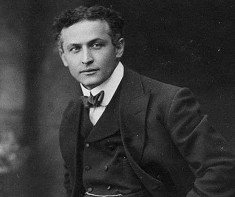| Harry Houdini | |
|---|---|
 |
|
| Magician | |
| Born | March 24, 1874 |
| Died | Oct. 31, 1926 |
| Nationality | Hungarian-American |
Harry Houdini was a magician who specialized in escape scenarios. He was of Hungarian and American descent and first came into prominence in Europe using the title of Harry “Handcuff” Houdini. This act involved law enforcement officials restraining him to the best of their ability with him eventually escaping from their constraints.
Early Years
Harry Houdini’s given name at birth was Erik Weisz, but he was soon given the nickname “Harry.” He was born in Budapest, Austria-Hungary on March 24, 1874. His father was a rabbi and Eric was the fourth of seven children.
Weisz traveled to the United States in July of 1878 along with his mother and four brothers. The family settled in Appleton, Wisconsin, where his father joined them to head a Jewish congregation. Approximately nine years later, the family relocated to New York City.
Beginning in Show Business
Houdini performed on a trapeze at the age of nine. When he began his career as a professional magician, he took his childhood nickname of Harry and added an “I” to the end of Houdin in reverence to Robert-Houdin, a person whom he admired at the time.
Later, he claimed that using the name Harry was meant to honor magician Harry Kellar. He later expressed contempt for his former hero, Houdin, whom he felt had misrepresented himself in the creation of automata and aerial suspension effects.
Major Achievements in Magic
In 1901, Houdini presented the “Milk Can Escape” for the first time. This act involved him being sealed in an oversized milk container, commonly used in the early 20th century, with it being filled with water. While behind a curtain, he would free himself while encouraging his audience to hold their own breath while the feat was being accomplished.
As the trick gained prominence, he enhanced it with the addition of the milk can being inserted into a wooden chest that was then secured by padlocked chains. In 1912, the milk can was replaced by the “Chinese Water Torture Cell” adding more difficulty to the exercise.
Houdini began performing the “Daily Mirror Challenge” in 1904. In this trick, Houdini was challenged to escape from a pair of handcuffs specially manufactured over a five-year period of time. Over 4,000 spectators watched for over an hour as he seemingly struggled. Eventually, he emerged from behind a curtain free of the bracelets that had shackled him.
Buried Alive
 Perhaps Houdini’s most prominent accomplishment was his “Buried Alive” trick. The first attempt at this trick nearly cost him his life, as he required help in digging himself out from six feet under the ground where he had been placed without a casket.
Perhaps Houdini’s most prominent accomplishment was his “Buried Alive” trick. The first attempt at this trick nearly cost him his life, as he required help in digging himself out from six feet under the ground where he had been placed without a casket.
The second variation of being buried alive was accomplished under water where Houdini escaped from a sealed coffin dropped to the bottom of a swimming pool. The third genesis of the buried alive trick occurred with him being submerged in sand while wearing a straitjacket and sealed inside a container.
Death and Legacy
As fate would have it, Harry Houdini passed away on Halloween of 1926 at the age of 52. The official cause of death was listed as peritonitis, which was the result of a ruptured appendix. The condition was undoubtedly caused by his insistence on having another man strike him repeatedly in the stomach as part of an exhibition of pain control. Houdini ignored signs of the trauma for two days while continuing to perform.
To the end of his life, he refuted spiritualists who claimed to be able to communicate with the deceased. Before his passing, Houdini set up a secret password with his wife that he said he would use if ever contacted in the afterlife. After 10 attempts at séances on Halloween in an attempt to connect with him, Bess Houdini ended the quest unfulfilled.